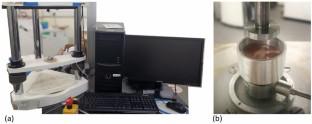Biomechanics and Modeling in Mechanobiology ( IF 3.5 ) Pub Date : 2024-03-14 , DOI: 10.1007/s10237-024-01833-7 Weiqi Li , Duncan E. T. Shepherd , Daniel M. Espino

|
Understanding the viscoelastic behavior of pediatric brain tissue is critical to interpret how external mechanical forces affect head injury in children. However, knowledge of the viscoelastic properties of pediatric brain tissue is limited, and this reduces the biofidelity of developed numeric simulations of the pediatric head in analysis of brain injury. Thus, it is essential to characterize the viscoelastic behavior of pediatric brain tissue in various loading conditions and to identify constitutive models. In this study, the pediatric porcine brain tissue was investigated in compression with determine the viscoelasticity under small and large strain, respectively. A range of frequencies between 0.1 and 40 Hz was applied to determine frequency-dependent viscoelastic behavior via dynamic mechanical analysis, while brain samples were divided into three strain rate groups of 0.01/s, 1/s and 10/s for compression up to 0.3 strain level and stress relaxation to obtain time-dependent viscoelastic properties. At frequencies above 20 Hz, the storage modulus did not increase, while the loss modulus increased continuously. With strain rate increasing from 0.01/s to 10/s, the mean stress at 0.1, 0.2 and 0.3 strain increased to approximate 6.8, 5.6 and 4.4 times, respectively. The brain compressive response was sensitive to strain rate and frequency. The characterization of brain tissue will be valuable for development of head protection systems and prediction of brain injury.
中文翻译:

受压的小儿猪脑组织的频率和时间依赖性粘弹性特征
了解儿童脑组织的粘弹性行为对于解释外部机械力如何影响儿童头部损伤至关重要。然而,对儿科脑组织粘弹性特性的了解有限,这降低了在脑损伤分析中开发的儿科头部数值模拟的生物保真度。因此,有必要表征儿童脑组织在各种负载条件下的粘弹性行为并确定本构模型。在这项研究中,对小儿猪脑组织进行了压缩研究,分别测定了小应变和大应变下的粘弹性。应用 0.1 至 40 Hz 之间的频率范围,通过动态机械分析确定频率相关的粘弹性行为,而脑样本分为 0.01/s、1/s 和 10/s 三个应变率组,压缩高达 0.3应变水平和应力松弛以获得随时间变化的粘弹性能。在频率高于20 Hz时,储能模量没有增加,而损耗模量不断增加。随着应变速率从0.01/s增加到10/s,0.1、0.2和0.3应变下的平均应力分别增加到大约6.8、5.6和4.4倍。大脑的压缩反应对应变率和频率敏感。脑组织的表征对于头部保护系统的开发和脑损伤的预测具有重要意义。



























 京公网安备 11010802027423号
京公网安备 11010802027423号